L’Oreal Paris Revitalift Glycolic Peel Pads
L’Oreal Paris Revitalift Glycolic Peel Pads Review
A whole lot of people are starting to appreciate the benefits of using gentle acids on the skin for renewal and radiance and one of the easiest ways to carry out this step is with peel pads. I have been checking out the L’Oreal Paris Revitalift Glycolic Peel Pads which have been a huge success in the US. They have finally launched in the UK and I have all the information you need right here. It’s great to see a product like this available on the high street.
L’Oreal Paris Revitalift Glycolic Peel Pads
This is the extra step in your skincare if you want a non-abrasive exfoliator to help reveal your skin’s natural radiance. It will work to reduce the look of texture, enlarged pores and fine lines and wrinkles, and also allow your subsequent skincare products to penetrate more effectively.
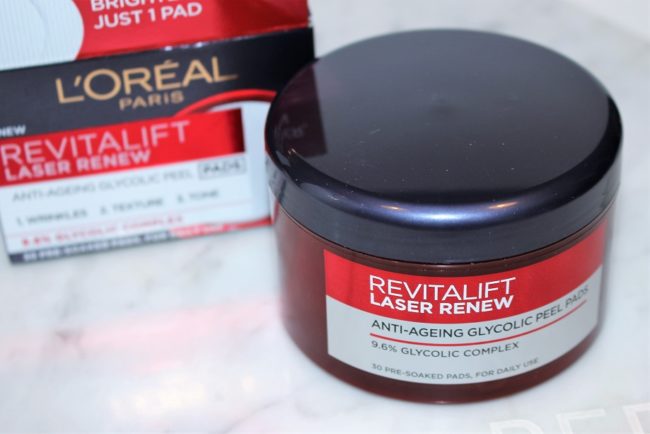
L’Oreal Paris Revitalift Glycolic Peel Pads
There are 30 peel pads in a tub, so you have enough in one tub to exfoliate your skin for a month. And after 30 days, we are told to expect some impressive results.
It’s not something new: it was introduced around 1950 and today it can be used up to 1% worldwide. It can be found in nature – in green tea – but the version used in cosmetics is synthetic.
Revitalift bright reveal peel pads reviews
Good old water, aka H2O. The most common skincare ingredient of all. You can usually find it right in the very first spot of the ingredient list, meaning it’s the biggest thing out of all the stuff that makes up the product.
It’s mainly a solvent for ingredients that do not like to dissolve in oils but rather in water.
Expand to read more
Once inside the skin, it hydrates, but not from the outside – putting pure water on the skin (hello long baths!) is drying.
One more thing: the water used in cosmetics is purified and deionized (it means that almost all of the mineral ions inside it is removed). Like this, the products can stay more stable over time.
- It’s a super common and super debated skincare ingredient
- It has several benefits: great solvent, penetration enhancer, creates cosmetically elegant, light formulas, great astringent and antimicrobial
- It can be very drying if it’s in the first few ingredients on an ingredient list
- Some experts even think that regular exposure to alcohol damages skin barrier and causes inflammation though it’s a debated opinion (read more in geeky details tab)
We don’t have description for this ingredient yet.
- It’s a helper ingredient that improves the freeze-thaw stability of products
- It’s also a solvent, humectant and to some extent a penetration enhancer
- It has a bad reputation among natural cosmetics advocates but cosmetic scientists and toxicology experts do not agree (read more in the geeky details section)
- A natural moisturizer that’s also in our skin
- A super common, safe, effective and cheap molecule used for more than 50 years
- Not only a simple moisturizer but knows much more: keeps the skin lipids between our skin cells in a healthy (liquid crystal) state, protects against irritation, helps to restore barrier
- Effective from as low as 3% with even more benefits at higher concentrations up to 20-40% (around 10% is a good usability-effectiveness sweet spot)
- High-glycerin moisturizers are awesome for treating severely dry skin
- It’s the most researched AHA with the most proven skin benefits
- It gently lifts off dead skin cells to reveal newer, fresher, smoother skin
- It can help skin’s own collagen production that results in firmer, younger skin
- It can fade brown spots caused by sun damage or PIH
- Choose a product where you know the concentration and pH value because these two greatly influence effectiveness
- Don’t forget to use your sunscreen (in any case but especially so next to an AHA product)
- Slight stinging or burning with a stronger AHA product is normal
- If your skin is very sensitive, rosacea prone choose rather a BHA or PHA product
The unfancy name for it is lye. It’s a solid white stuff that’s very alkaline and used in small amounts to adjust the pH of the product and make it just right.
For example, in case of AHA or BHA exfoliants, the right pH is super-duper important, and pH adjusters like sodium hydroxide are needed.
Expand to read more
BTW, lye is not something new. It was already used by ancient Egyptians to help oil and fat magically turn into something else. Can you guess what? Yes, it’s soap. It still often shows up in the ingredient list of soaps and other cleansers.
Sodium hydroxide in itself is a potent skin irritant, but once it’s reacted (as it is usually in skin care products, like exfoliants) it is totally harmless.
Citric acid comes from citrus fruits and is an AHA. If these magic three letters don’t tell you anything, click here and read our detailed description on glycolic acid, the most famous AHA.
So citric acid is an exfoliant, that can – just like other AHAs – gently lift off the dead skin cells of your skin and make it more smooth and fresh.
Expand to read more
There is also some research showing that citric acid with regular use (think three months and 20% concentration) can help sun-damaged skin, increase skin thickness and some nice hydrating things called glycosaminoglycans in the skin.
But according to a comparative study done in 1995, citric acid has less skin improving magic properties than glycolic or lactic acid. Probably that’s why citric acid is usually not used as an exfoliant but more as a helper ingredient in small amounts to adjust the pH of a formulation.
A form of skincare superstar, vitamin C. If you do not know why vitamin C is such a big deal in skincare, we have a really detailed, geeky description that’s good to read. 🙂
So now you know that because pure vitamin C is such a diva (very unstable and hard to formulate) the cosmetic industry is trying to come up with some derivatives that have the badass anti-aging properties of vitamin C (antioxidant protection + collagen boosting + fading hyperpigmentation) but without the disadvantages. This is a hard task, and there is not yet a derivative that is really proven to be better in every aspect, but Ascorbyl Glucoside is one of the best options when it comes to vitamin C derivatives. Let’s see why:
Expand to read more
First, it’s really stable and easy to formulate, so the problems that come with pure vitamin C are solved here.
Second, in vitro (meaning made in the lab, not on real humans) studies show that ascorbyl glucoside can penetrate the skin. This is kind of important for an anti-aging ingredient to do the job, so this is good news, though in-vivo (made on real humans) studies are still needed.
Third, in-vitro studies show that after ascorbyl glucoside is absorbed into the skin it is converted to pure vitamin C (though the rate of conversion is still a question mark). It also shows all the three anti-aging benefits (antioxidant protection + collagen boosting + fading hyperpigmentation) that pure vitamin C does.
Bottom line: ascorbyl glucoside is one of the best and most promising vitamin C derivatives that shows similar benefits to that of pure vitamin C, but it’s less proven (in vivo vs. in vitro studies) and the extent of the benefits are also not the same.
A helper ingredient that usually comes to the formula coupled with PEG-40 Hydrogenated Castor Oil. The two together work as surfactants and oil solubilizers. It’s a non-sticky duo that works at low concentration and is often used to solubilize fragrance components into water-based formulas.
A mildly viscous, amber-colored liquid with fatty odor, made from Castor Oil and polyethylene glycol (PEG).
If it were a person, we’d say, it’s agile, diligent & multifunctional. It’s mostly used as an emulsifier and surfactant but most often it is used to solubilize fragrances into water-based formulas.
Exactly what it sounds: nice smelling stuff put into cosmetic products so that the end product also smells nice. Fragrance in the US and parfum in the EU is a generic term on the ingredient list that is made up of 30 to 50 chemicals on average (but it can have as much as 200 components!).
If you are someone who likes to know what you put on your face then fragrance is not your best friend – there’s no way to know what’s really in it.
Expand to read more
Also, if your skin is sensitive, fragrance is again not your best friend. It’s the number one cause of contact allergy to cosmetics. It’s definitely a smart thing to avoid with sensitive skin (and fragrance of any type – natural is just as allergic as synthetic, if not worse!).
A super common and cheap fragrance ingredient. It’s in many plants, e.g. rosemary, eucalyptus, lavender, lemongrass, peppermint and it’s the main component (about 50-90%) of the peel oil of citrus fruits.
It does smell nice but the problem is that it oxidizes on air exposure and the resulting stuff is not good for the skin. Oxidized limonene can cause allergic contact dermatitis and counts as a frequent skin sensitizer.
Expand to read more
Limonene’s nr1 function is definitely being a fragrance component, but there are several studies showing that it’s also a penetration enhancer, mainly for oil-loving components.
All in all, limonene has some pros and cons, but – especially if your skin is sensitive – the cons probably outweigh the pros.
It’s pretty much the current IT-preservative. It’s safe and gentle, but even more importantly, it’s not a feared-by-everyone-mostly-without-scientific-reason paraben.
It’s not something new: it was introduced around 1950 and today it can be used up to 1% worldwide. It can be found in nature – in green tea – but the version used in cosmetics is synthetic.
Expand to read more
Other than having a good safety profile and being quite gentle to the skin it has some other advantages too. It can be used in many types of formulations as it has great thermal stability (can be heated up to 85°C) and works on a wide range of pH levels (ph 3-10).
It’s often used together with ethylhexylglycerin as it nicely improves the preservative activity of phenoxyethanol.
Biosaccharide Gum-1 is a pretty interesting kind of sugar ingredient that is created from sorbitol via bacterial fermentation.
According to the manufacturer it’s a “S.M.A.R.T.” sugar: it has Soothing, Moisturizing, Anti-aging, Restructuring and Touch properties. Let’s look at them quickly one by one.
Expand to read more
Soothing: the manufacturer tested out the soothing effect in vivo (meaning on humans that is always a good thing!) by measuring how 3% Biosaccharide Gum-1 decreased the tingling sensation caused by 10% lactic acid. The result was good: the tingling was decreased by 47%.
Moisturizing: Compared to famous hyaluronic acid, it turns out that the two are great together. HA has a quicker effect and provides more instant hydration (much more hydration was measured after 1h of application), while our nice sugar has a somewhat delayed effect demonstrating stronger hydration after 3h of application. After 8 hours both had similar moisturizing effect.
Anti-aging: According to ex-vivo tests (meaning not on humans, so do not trust it too much) Biosaccharide Gum-1 can stimulate a protein in our skin called sirtuin-1. This is supposed to help our skin cells to live longer, and function better.
Resurfacing: The sirtuin-1 stimulation also results in quicker cell renewal – something that happens anyway but slows down as we age. And the quicker cell renewal is good because it helps the regeneration of the barrier function. That is especially nice for fragile, sensitive skin.
Touch: our fermented sugar is not only good to the skin, but it also feels great on the skin. It gives a nice “soft touch” feeling and makes the products pleasant to use.
The bottom line is that the above info is from the manufacturer (and we could not find any relevant independent research) so obviously take it with a grain of salt. But Biosaccharide Gum-1 does look as an interesting and promising ingredient that’s why it earned our goodie rating.
A common fragrance ingredient that smells like jasmine. It is one of the “EU 26 fragrances” that has to be labelled separately because of allergen potential. Best to avoid if your skin is sensitive.
Linalool is a super common fragrance ingredient. It’s kind of everywhere – both in plants and in cosmetic products. It’s part of 200 natural oils including lavender, ylang-ylang, bergamot, jasmine, geranium and it can be found in 90-95% of prestige perfumes on the market.
The problem with linalool is, that just like limonene it oxidises on air exposure and becomes allergenic. That’s why a product containing linalool that has been opened for several months is more likely to be allergenic than a fresh one.
Expand to read more
A study made in the UK with 483 people tested the allergic reaction to 3% oxidised linalool and 2.3% had positive test results.
It’s a common fragrance ingredient that has a light floral smell. It’s one of the “EU 26 fragrances” that has to be labelled separately (and cannot be simply included in the term “fragrance/perfume” on the label) because of allergen potential. Best to avoid if your skin is sensitive.
L’Oreal finally gets in the AHA (alpha hydroxy acid) category with their Revitalift® Bright Reveal Brightening Daily Peel Pads. These soft, nicely-sized pads contain what the brand describes on the product’s box as “10% glycolic complex”. We’re not sure what that means but as far as the ingredient list is concerned it is highly unlikely the formula contains 10% glycolic acid. That’s too bad, because 10% glycolic acid is an impressive, effective amount for a product labeled “peel”.
Revitalift® Bright Reveal Brightening Daily Peel Pads
L’Oreal finally gets in the AHA (alpha hydroxy acid) category with their Revitalift® Bright Reveal Brightening Daily Peel Pads. These soft, nicely-sized pads contain what the brand describes on the product’s box as “10% glycolic complex”. We’re not sure what that means but as far as the ingredient list is concerned it is highly unlikely the formula contains 10% glycolic acid. That’s too bad, because 10% glycolic acid is an impressive, effective amount for a product labeled “peel”.
Unlike many AHA products, this one’s formula is pH-correct. The pH of 3.6 means the AHA will work to exfoliate skin—so even if the amount of glycolic acid is below 10% (we suspect it’s hovering between 3—5% but L’Oreal wouldn’t confirm the amount), you’ll still see skin-smoothing, tone-improving benefits. Products with 10% glycolic acid typically list the ingredient much higher up on the list, but since it’s the seventh one listed here, we’re skeptical that the “10% glycolic complex” is actually 10% glycolic acid. It’s more likely that in calling it a “complex”, L’Oreal may be including other ingredients, but the brand wouldn’t confirm this when we called.
Not really disappointing so far, but, as they say, wait for it: The pads are stepped in a potentially sensitizing amount of denatured alcohol—the kind that’s a turn for the worse for all skin types. See More Info to learn why seeing this much alcohol in any skincare product is a problem.
Interestingly, even though the formula also contains fragrance, the pads don’t have a perfume-y scent. Instead, you get a strong hit from the alcohol, which fades as you apply to skin. Despite this, seeing fragrance in a product with denatured alcohol and a potentially moderate amount of glycolic acid at a lower pH isn’t doing your skin any favors.
Another concerning ingredient is hydroxyethylpiperazine ethane sulfonic acid (also known as HEPES). It’s a buffering ingredient (typically used to establish a neutral pH) with research indicating it can generate free radical damage in the presence of oxygen (Journal of Inorganic Biochemistry, August 2005, pages 1,653-1,660 and November 2004, issue 11, pages 1696-1702). That has us worried even though research on how this directly impacts skin hasn’t been done. Still, there are definitely other buffering agents that could have been used instead of this seemingly problematic one.
With some minor tweaks, these daily-use pads could’ve been a great (though ultimately pricey) way to visibly improve skin in multiple ways. Instead, we urge you to check out our list of Best AHA Exfoliants for better ways to see younger, smoother-looking skin.
- Contains glycolic acid formulated within the right pH range for exfoliation to occur.
- Soft, nicely-sized pads are easy to use.
- Amount of alcohol poses a risk of sensitizing skin.
- Contains an ingredient that could potentially promote free radical damage.
- Amount of AHA glycolic acid might be less than what’s touted on the box.
- Fragrance ingredients pose a risk of sensitizing skin (though these pads don’t have a perfume-y scent).
- Meant for daily use, but the price doesn’t make these pads a wise buy.
Alcohol-Based Skincare Products: Alcohol’s effect on your skin is similar to its effect on the rest of your body: it steals the good (hydration) and leaves the bad (dryness, redness, and discomfort). Research has made it clear that alcohol as a main ingredient in any skincare product you use repeatedly is a problem.
When we express concern about the presence of alcohol in skincare or makeup products, we’re referring to denatured ethanol, which you’ll most often see listed as SD alcohol, alcohol denat, denatured alcohol, or isopropyl alcohol on the ingredient label.
When you see these names of this type of alcohol listed among the first six ingredients on an ingredient label, without question they will aggravate and be cruel to skin. No way around that, it’s simply bad for all skin types.
These types of volatile alcohols give products a quick-drying finish, immediately degrease skin, and feel weightless, so it’s easy to see their appeal, especially for those with oily skin. But those short term benefits lead to negative long term outcomes!
Consequences include dryness, erosion of skin’s surface (that’s really bad for skin), and a strain on how skin replenishes, renews, and rejuvenates itself. Alcohol just weakens everything about skin.
We are often challenged on this information based on a study in the British Journal of Dermatology, July 2007, issue 1, pages 74-81 that concluded “alcohol-based hand rubs cause less irritation than hand washing…” The only thing this study showed is that alcohol was not as irritating as an even more irritating hand wash containing sodium lauryl sulfate. Think about it this way, if you test to see whether or not you’ll get burnt by a flame or slowly boiling hot water, you will quickly get damaged by the fire. You will eventually be damaged by the slowly boiling hot water it will just take longer, but burned you will be.
There are other types of “alcohols”, known as fatty alcohols, which are absolutely non-irritating and can be exceptionally beneficial for skin. Examples you’ll see on ingredient labels include cetyl, stearyl, and cetearyl alcohol. All of these are good ingredients for skin. It’s important to discern these skin-friendly forms of alcohol from the problematic types of alcohol.
The irony of using alcohol-based products to control oily skin is that the damage from alcohol can lead to an increase in bumps and enlarged pores. Alcohol can actually increase oiliness because of the irritating feeling it creates, so the immediate de-greasing effect is eventually counteracted, prompting your oily skin to look even shinier.
References for this information
Dermato-Endocrinology, January 2011, issue 1, pages 41-49
Experimental Dermatology, June 2008, issue 6, pages 542-551
Alcohol Journal, April 2002, issue 3, pages 179-190
Aging, March 2012, issue 3, pages 166-175
Chemical Immunology and Allergy, March 2012, pages 77-80
Journal of Occupational Medicine and Toxicology, November 2008, issue 3
Clinical Dermatology, September-October 2004, issue 5, pages 360-366.
I have a confession to make. From last March until September, I neglected my regular beauty routine and my skin wasn’t looking too good. Because of some personal difficulties, I wasn’t feeling too excited about several things in my life which including putting in alot of effort into my personal appearance. A few weeks ago I made some hard decisions in my life, which I’m pretty excited about and will share soon, and I decided it was time to get back to basics and start looking as good as I felt. It was at that time that I received L’Oreal’s new RevitaLift Bright Reveal Collection free to test out and review, which I took as a sign that I made the right decisions!
L’Oreal RevitaLift Bright Reveal Skincare Collection Review

I have a confession to make. From last March until September, I neglected my regular beauty routine and my skin wasn’t looking too good. Because of some personal difficulties, I wasn’t feeling too excited about several things in my life which including putting in alot of effort into my personal appearance. A few weeks ago I made some hard decisions in my life, which I’m pretty excited about and will share soon, and I decided it was time to get back to basics and start looking as good as I felt. It was at that time that I received L’Oreal’s new RevitaLift Bright Reveal Collection free to test out and review, which I took as a sign that I made the right decisions!
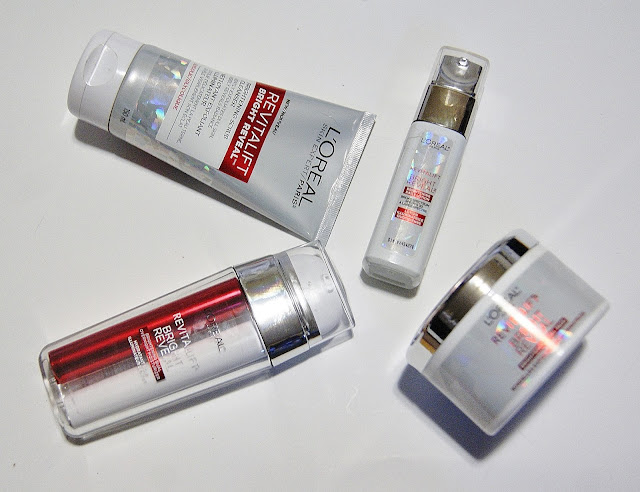
The L’Oreal RevitaLift Bright Reveal Collection includes a Brightening Scrub Cleanser, Brightening Peel Pads, Brightening Dual Moisturizer, and Brightening Daily Lotion and are packed with anti-aging ingredients including Vitamin GC Acid, Hepes, Glycolic Acid (formulated with 10% – one of the highest amounts found in drugstores), Perlite, and Retinol. Which is great for someone who is closer to 40 than 30 (but still doesn’t look it:).
L’Oreal boasts that the new RevitaLift Bright Reveal skincare routine will reveal brighter, smoother and more even skin within one week. What I noticed was that my skin looked brighter, felt smoother and softer and had a more even skin tone after just one use!
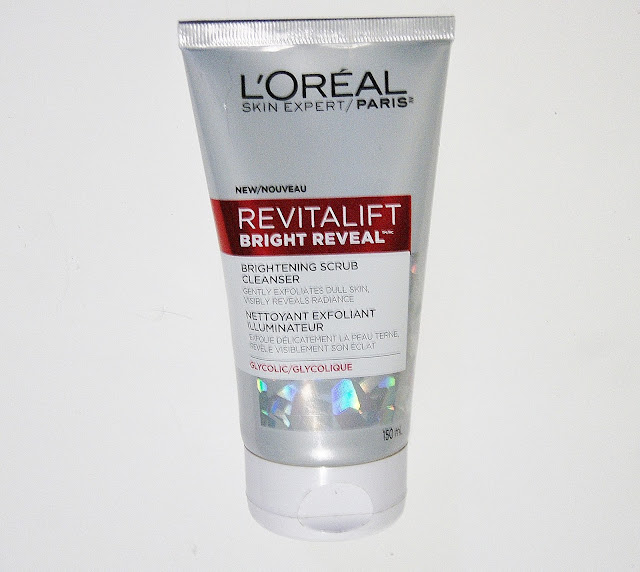
The Brightening Scrub Cleanser is a daily cleanser that has a fresh citrus scent, which is great for those mornings that I needed an extra pick-me-up. I only needed to use a small amount of the scrub, which has small granules in the gel to help exfoliate my skin. It rinsed off easily and left my skin feeling fresh and looking bright. But after two weeks, I had to start using the Brightening Scrub Cleanser only about three times a week. I suffer from adult acne and when the blemishes first appear they are big and red (thank goodness for good concealers:). My blemishes usually only last about one week, but I found the scrub irritated them and they still looked big and red after one week. After cutting the scrub down to using it three times a week, the blemishes started to finally disappear. And my skin still looked fabulous.
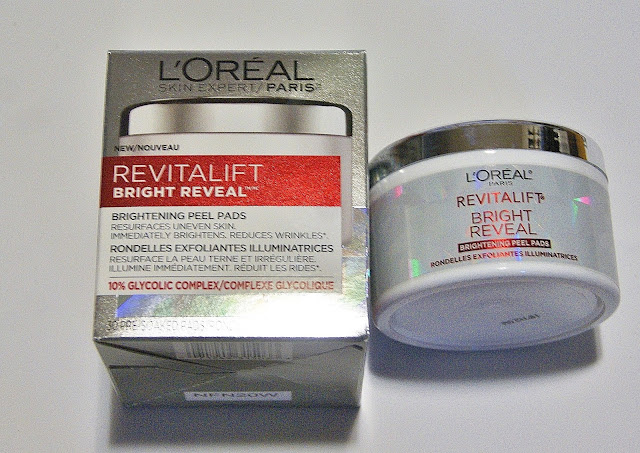
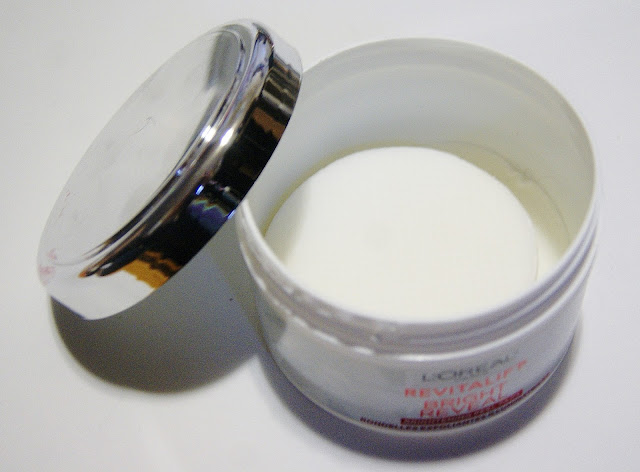
The Brightening Peel Pads are pre-soaked in a 10% Glycolic Complex and are meant to be used at night after cleansing. The pads are have a slight texture to them which gave some extra exfoliation to my skin, which it needed after months of neglect. I also noticed some leftover makeup and dirt on the pad, even after cleansing. For the first two weeks, my skin felt and looked great but, I had to cut down use of the pads to three times a week because of my blemishes. But as an added bonus, cutting down use extended the product since only 30 pads come in the container.
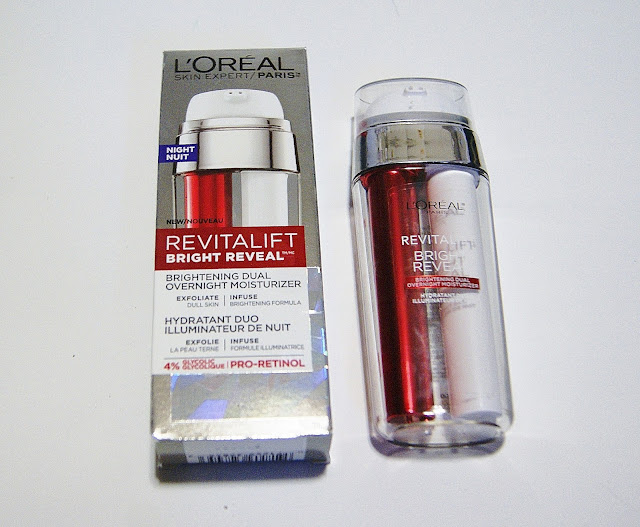
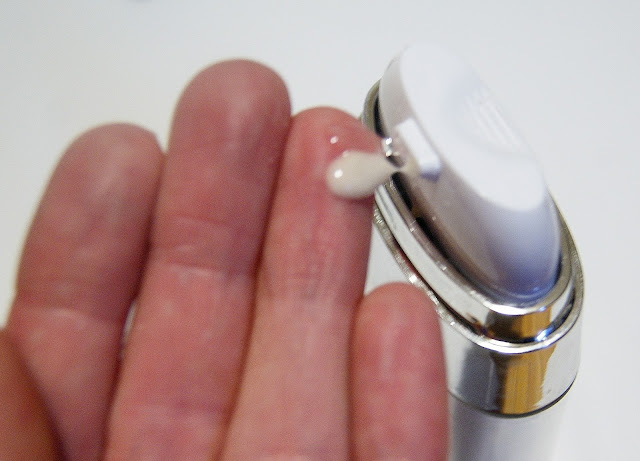
The Brightening Dual Overnight Moisturizer is my favourite product of the collection (although I loved all of them). It has both an overnight lotion and serum in one package and both come out separately when I pump the tube. It’s perfect for someone like myself who is just too tired, or lazy, to apply a serum and overnight lotion separately. And I could still feel the lotion on my skin in the morning even after sleeping with it on for six hours – eight hours if I’m lucky. This lotion made my skin feel soft and silky.

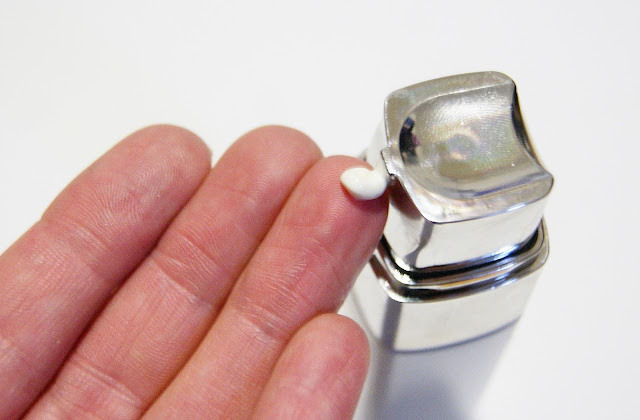
The Brightening Daily Lotion has a SPF 30 and goes on quite thickly, although my skin does soak it up pretty quickly. I also noticed that I only needed to use a small amount to cover my whole face and it made my skin feel soft and my makeup was easier to apply after using this lotion.
I’m so happy I tried out the L’Oreal RevitaLift Bright Reveal Collection. It made my skin look amazing, which made me feel awesome! The only drawback of using this collection on a daily basis is that the scrub and pads were a little much for daily use, so it might not be good for those with sensitive skin. Although I’m happy I used both products for two weeks straight to get my skin back to looking bright and feeling soft. Now I just need to keep it up!
L’Oreal RevitaLift Bright Reveal products retail for about $12.99 – $30.99 and can be found at drugstores and mass retailers.